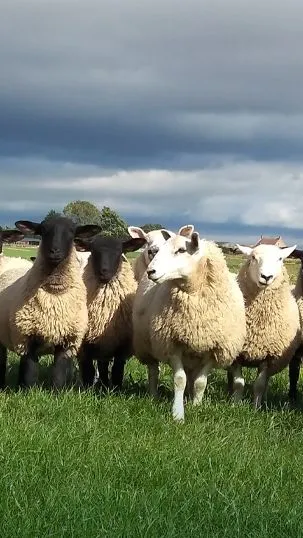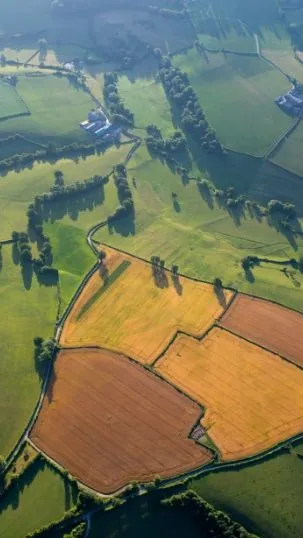
Britain’s best-known and loved grantor
Glastonbury guru Michael Eavis is idolised by superstars and music fans alike
When Beatles icon Paul McCartney walks on stage, guitar in hand, to headline this year's Glastonbury, it will mark a Phoenix-like rebirth for one of the country’s best-loved grantors.
At 86, Michael Eavis is still revered as the godfather of the world’s best known and loved festival which returns with a vengeance this year. Over five days in June, the 1,000 acre site he runs with daughter Emily will host 203,000 visitors watching 2,800 acts on 100 stages and visiting 800 market stalls. So the logistics required to transform the lush fields of Pilton in Somerset that are usually home to 500 milking cows and 500 young stock into a rock and roll Mecca – and then back again – are considerable.

The godfather of Glastonbury, Michael Eavis, with daughter Emily
Well before Diana Ross belts out Ain’t No Mountain High Enough at Glastonbury 2022, the cows that help produce the award-winning Worthy Cheddar will have been tucked away at a specially built Moo-tel for weeks. The fields that have fallen silent since the last Glasto in 2019 will once again reverberate to the sound of some of the world’s greatest musicians, for whom an invite from this grantor means a career highlight.
And it’s a return that cannot come a day too soon for Michael, who warned of looming bankruptcy if the event had not been able to go ahead this year, adding: “We had to carry on, otherwise it would have been. I don’t think we could have waited another year.” Michael, who inherited the farm when he was 19, is a master of diversification, sustainably organising one of the biggest festivals in the world while also supporting charity.
“The figures for our last festival showed we raised around £2m a year, with WaterAid, Oxfam and Greenpeace the main beneficiaries along with local charities, good causes and community groups.”
Michael Eavis







24h
The festival site never sleeps and even on the final day teams work through the night to repair the site’s roads for the mass exodus.
200
Glastonbury uses electricity from 200 generators around the site, with the rest coming from renewable solar and wind sources.
8km
The site is completely surrounded by a 15-feet high ‘superfortress’ fence, stretching over 8km in length, to prevent unofficial invasions by gatecrashers.

Environmentally responsible festival
While acknowledging that the greenest option would be not to hold it at all, festival organiser Michael is determined to set the standard for environmentally responsible large events. “The festival has this image of being a rather non-stop hedonistic indulgence, but at Glastonbury it’s important to get across the message that we also put a lot back, looking after the environment and running the festival as sustainably as possible,” he said.
“The land is primarily managed as a dairy farm producing more than 14,000 litres of milk a day and as far as dairy farming is concerned, putting on the festival is a perfect use of the land because the permanent pasture is cut for silage in May, we clean up the fields for the festival in June and then afterwards it all recovers and the cows come out again.”
Then, the only sign of the festival that remains is the steel skeleton of the giant Pyramid Stage and the seven National Grid towers that cross the landscape from east to west.

Sustainability
Renewable energy has been a feature of Glastonbury since 1979, with the Green Fields area leading the way in major public events for its use of solar and wind power to heat the showers and generators that run on bio-diesel sourced from hydrotreated vegetable oil.
Michael also installed 1,500 square metres of solar panels on the roof of the cattle shed in 2010, making it one of the largest privately owned solar photovoltaic systems in the country. The 1,300 plus panels save around 100 tonnes of carbon dioxide emissions each year, generating 205,700kWh of energy – enough to supply 40 average households a year.
Meanwhile a new anaerobic digestion plant using cow slurry, food waste or energy crops to power backstage and production areas via a 125kVA generator is close to completion.

Cutting emissions
“It’s further proof that everyone at the Festival is committed to reducing greenhouse emissions and using clean energy sources whenever possible,” says Michael before adding: “Even our offices on Worthy Farm are heated by a ground source heat pump and 185 low energy LED tower lights are used on site.”
Thousands of trees have been planted during the past 20 years, along with miles of hedgerow and a new pond, while wildlife sanctuaries are created during the festival to protect birds and animals.
Glastonbury camping
Even in the Covid years, Michael and Emily Eavis thought outside the box, setting up the Worthy Pastures family-friendly campsite at the tail end of 2021 to offer morale-boosting work to the crew. And despite the bi-annual operation, Michael remains as upbeat and enthusiastic about dairy farming, the environment and the musical showpiece as he was before the first one in 1970 when The Kinks headlined in front of just 1,500 people.
National Grid is a support act
Such a power-driven event inevitably needs support from partners, which is where National Grid steps in each festival year to ensure public safety is maintained around the 400kV overhead power line.
Extra security fencing goes up around the towers while linesmen ensure the integrity of the anti-climbing guards before, during and after the event. Add in the need for a water supply and sewage as reliable as the electricity – along with a need to reduce the carbon footprint – and the equation doesn’t get any less complicated.

Keeping tradition alive
The work is almost constant in the build-up to and exodus from the event, when the serious business of creating some of the best cheeses in England continue a Worthy Farm tradition started by Michael's Caerphilly-making grandfather. “That was more than a century ago and he continued until the mid 1920s, but now, after 50 years of recent festival history, Worthy Farm milk is being made into cheese again, so it’s something of a comeback.”
And as the last echoes of Hey Jude fade into the distance past the Glastonbury Tor, it will be back to the daily routine for the Eavis family… until their next five days of fame at Glastonbury 2023.
Images courtesy of: © Jason-Bryant, © Matt Cardy, © Andrew Allcock.






